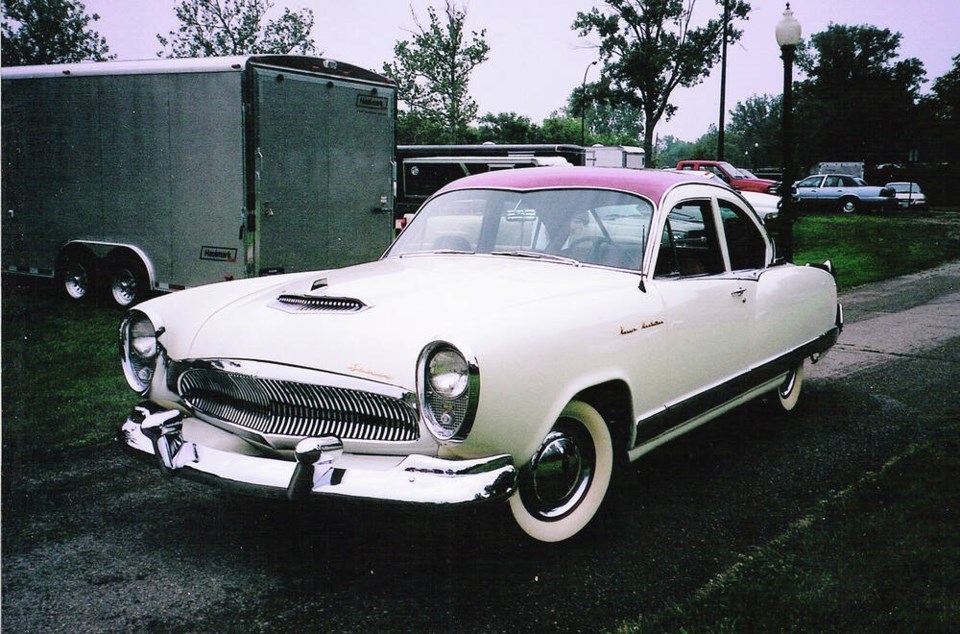Following the Second World War, several entrepreneurs were attracted to automobile building in North America. They were enticed by the car shortage resulting from low production during the Depression, and a 3-1/2 year war-time shutdown. Most faded quickly, but the longest-running Kaiser-Frazer lasted a decade.
Right after the war in 1945 Henry J. Kaiser, a California construction and ship building magnate joined experienced auto executive Joseph W. Frazer president of Graham-Paige Motors to form the Kaiser-Frazer Corp. Kaiser brought his money and entrepreneurial drive and Frazer his automobile expertise, contacts and Graham-Paige assets.
Although Graham-Page hadn’t built an automobile since 1940 it had been active in war production. Kaiser-Frazer acquired a giant war surplus bomber plant in Willow Run, Michigan, just west of Detroit, on very favourable terms and converted it into the world’s largest automobile factory.
After experimenting with ideas like front-wheel drive, torsion bar springing, unit construction and fully-independent suspension, K-F finally settled on the conventional route with a front engine, rear drive, body-on-frame sedan.
K-F’s integrated fenders and new, full envelope styling were advanced compared with others except Studebaker whose new 1947 models arrived in the spring of 1946. A long 3,137 mm (123.5 in.) wheelbase gave K-F a spacious interior, between-the-axles seating and a comfortable ride.
To avoid the time and cost of developing an engine, K-F used a 3.7 litre (226 cu in.) side-valve, “Red Seal” inline Continental industrial six converted for automobile use. It developed 100 horsepower, or 112 with a two-barrel carburetor.
K-F announced the popularly priced Kaiser and upscale Frazer in January, 1946. Production began in June with an October launch as 1947 models.
It was a euphoric time for auto manufacturers. The pent-up demand had created a seller’s market and in this artificial environment K-F sold 70,474 Kaisers and 68,775 Frazers in the 1947 model year.
Prosperity continued in 1948 with almost 140,000 sales, but by 1949 conditions were changing. Demand was largely satisfied, and the Big Three (General Motors, Ford and Chrysler) and the smaller manufacturers had their all-new post-war models available.
In this environment, Kaiser sales slipped from 91,851 1948s to 94,750 for the combined 1949-‘50 model year. And in spite of introducing the industry’s first hatchback, the 1949 Traveller, Frazer sales sagged from 48,071 1948 models to only 24,720 ’49s and ’50s combined. Something was needed to invigorate K-F’s fortunes.
That something was the stunning 1951 Kaiser model. Frazer made do with revised 1950 styling, but it was near the end anyway. It departed early in 1951 due to low sales and Joe Frazer’s disagreement with the management of K-F by Henry Kaiser and his general manager son Edgar. With the Frazer Manhattan gone the Manhattan name was given to the top-of-the-line Kaiser.
Kaiser-Frazer stylist Howard “Dutch” Darrin and associates did a remarkable styling job on the ‘51 Kaiser, considered by many to be one of the most beautiful early post-war American cars.
The straight-line boxiness was replaced by a fender line that curved gently from the front to the rear window where it was relieved by a slight dip.
This dip — known as the Darrin Dip — was echoed in the middle of the windshield. A low, horizontal grille gave the Kaiser the then popular “road hugging” look.
This new styling rebounded Kaiser sales to 149,000 for 1951, including 1,360 cars built in K-F’s Toronto plant; production would cease there in 1952. Also in 1951, Kaiser-Frazer introduced the compact Henry J to compete with Nash’s popular Rambler.
Unfortunately for K-F, the public’s ardour cooled quickly, and in spite of the Manhattan name and lovely styling only 26,500 1952 Kaisers were sold. One of the reasons was that the little six lacked the power and smoothness of the V-8s most competitors had.
Although K-F had engineered an overhead valve V-8 they couldn’t afford to tool it up. Another factor was that buyers probably smelled failure and didn’t want to be left with an orphan.
The Manhattan limped through 1953 selling only 29,327 cars. To diversify and expand its line, K-F acquired Willys-Overland Inc., in 1953, manufacturer of the famous Jeep, and changed its name to Willys Motors Inc.
The Willow Run plant was sold to General Motors and the K-F operation was consolidated in the Willys-Overland home in Toledo, Ohio.
In an attempt to compensate for the lack of a V-8, the 1954 Manhattan’s “Supersonic” six was fitted with a belt-driven McCulloch supercharger. Although horsepower rose from 118 to 140 and improved Kaiser performance almost to V-8 levels, it wasn’t enough to save the Manhattan.
Production ceased in 1955 after just less than 1,300 Kaisers were built. Car-building was moved to Argentina and Brazil, and “The Last Onslaught on Detroit,” as Richard Langworth named his definitive Kaiser-Frazer book, was over.



